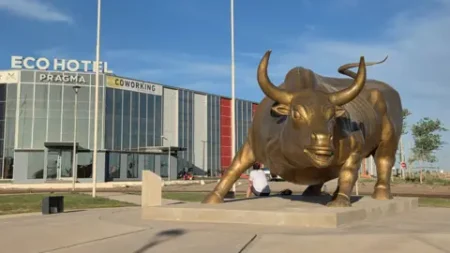In recent remarks that have raised eyebrows in political and economic circles, former President Donald Trump issued a warning reminiscent of historical economic downturns, specifically invoking the specter of a 1929-style crash. This alarm came in the context of the ongoing legal battles regarding the tariffs that his administration sought to implement, which he justified using emergency powers. After asserting that the U.S. economy is thriving, Trump cautioned that a ruling against his use of these powers by what he termed a “Radical Left Court” could lead to catastrophic economic repercussions.
In a post on Truth Social, Trump dramatically emphasized the potential fallout from a court decision that would invalidate his tariffs. “If … the largest amount of money, wealth creation and influence the U.S.A. has ever seen is disturbed,” he posited, “it would be impossible to ever recover, or pay back.” He further framed the stakes as existential for the nation’s economic standing, underscoring his belief that such a ruling would be tantamount to reigniting the Great Depression.
The backdrop to Trump’s pronouncement lies within a series of legal challenges against his tariff policies. In May, the U.S. Court of International Trade ruled that Trump had overstepped his authority with regard to these tariffs on foreign goods. An appeal was subsequently brought before the United States Court of Appeals for the Federal Circuit, where an 11-judge panel expressed skepticism over the administration’s legal basis for such aggressive tariff enforcement. As the judicial timeline unfolds, any adverse ruling for Trump could pave the way for an eventual Supreme Court appeal.
Trump’s comments have elicited surprise among both supporters and detractors because presidential warnings about economic catastrophe are not a common sight in American politics. The ramifications of his tariffs have often been regarded as potential threats to economic stability rather than safeguards. Art Hogan, the chief market strategist at B. Riley Wealth Management, countered Trump’s assertions by suggesting that if the courts were to strike down the tariffs, it could lead to a “massive celebration,” indicating a generally favorable view towards diminished trade barriers.
While Trump’s administration has indeed seen substantial tariff revenue growth, economist Gregory Daco from EY-Parthenon pointed out that these revenues—estimated between $70 billion and $80 billion—pale in comparison to the nearly $7 trillion that the federal government spent the previous year. Daco contended that the notion of tariffs being the linchpin of American economic stability is fundamentally flawed. He asserted, “The view that returning the custom duties would lead to a depression is largely misguided.” Instead, he hinted that reduced tariff rates could act as a stimulus to the economy rather than a detriment.
Moreover, Trump touted his trade strategies as a contributor to the robust performance of the U.S. stock market, claiming, “Tariffs are having a huge positive impact on the stock market.” However, analysts have diverged from this perspective, arguing that while stock prices surged to new highs this summer, factors such as economic recovery and corporate earnings played more significant roles than tariff revenue. Hogan notably refuted Trump’s claims by stating that the initial imposition of tariffs led to one of the steepest market downturns in decades, suggesting that market rebounds were contingent upon Trump’s eventual easing of aggressive tariff policies.
In conclusion, the ongoing discourse regarding Trump’s tariffs, their justification through emergency powers, and the underlying economic implications represents a critical juncture in the intersection of law, international trade, and economic policy in the United States. As legal challenges continue and the economic climate evolves, the ramifications of these tariffs and the president’s warnings about judicial decisions will likely reverberate through political and financial landscapes for some time.











